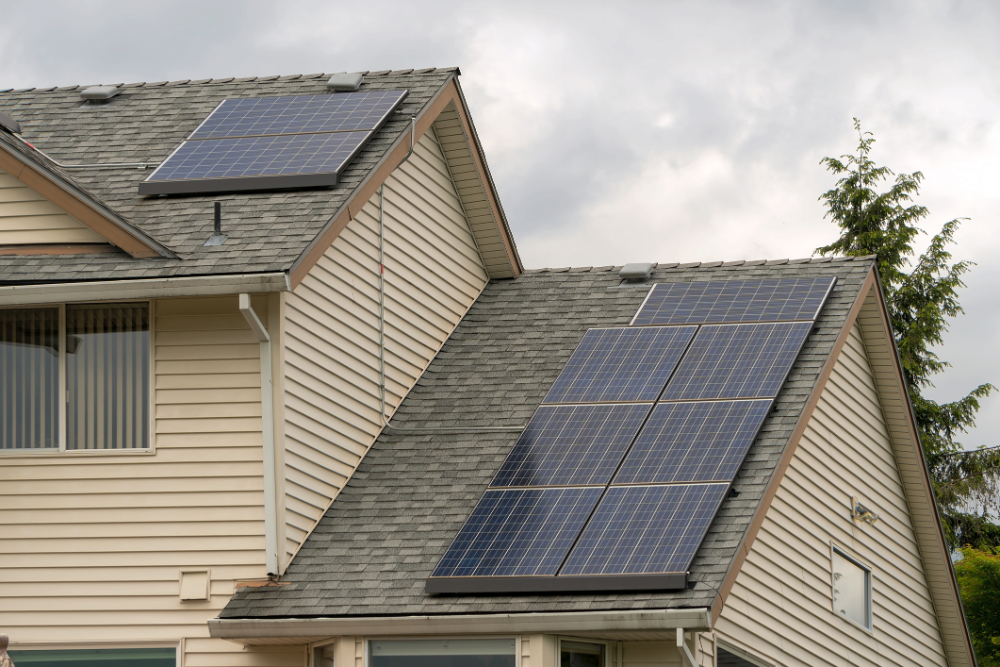Tips For Sustainable Home Improvement in Oregon
Sustainable homes are designed to have as low an impact on the environment as possible. Creating more sustainable homes is vital in today’s world and more and more people are becoming aware of the importance of green living. With concerns about climate change and extreme weather events such as floods and bushfires, many homeowners are looking for ways to make their property more energy-efficient and reduce their environmental impact.
Table of Contents

Here we’ll run you through the different ways, large and small, to make your home greener.
What are sustainable homes?
Sustainable homes are houses that are designed and built with the environment in mind. They are typically built with renewable and recycled materials, and are designed to reduce energy consumption. Sustainable homes also often have features that help to conserve water and improve indoor air quality.
Building a sustainable home or making your current one more sustainable can be a big part of reducing you and your family’s impact on the environment.
Sustainable homes in Oregon take into consideration the following factors:
- Building materials and methods
- Design and decorating choices
- Lighting
- Insulation
- Windows
- Heat, ventilation and air conditioning
- Plumbing fixtures
- Appliances
- Use of smart systems
- Energy generation from solar and wind
Why is there a need to conserve energy
There is a lot of controversy that surrounds the issue of climate change, especially when you include the difficulties that people are facing with ever rising energy costs. Whatever the true picture may be, it’s never a bad idea to be as efficient and cost effective as we can in regards to energy use.
Conserving energy helps to reduce greenhouse gas emissions, which more than likely contribute to climate change. Additionally, conserving energy will save you money on your energy bills.
Making even a few small changes in the way you use energy can make a big difference in your monthly bills. By conserving energy in sustainable homes in Oregon, your wallet and the environment will be in a better state.
How to make your home more sustainable
Sustainable homes respect natural resources by optimizing energy and water use. In the early stages of planning an eco-friendly home, look closely at features such as location, size and the orientation of the property. Designing a more sustainable house involves taking advantage of natural light and airflow to heat and cool the home naturally. This will give long term benefits for both the homeowner and the environment by reducing the energy consumption of cooling and heating systems.
Greener technology
The materials and the technology you incorporate into your home can have a massive difference in how green your house is.
- Install solar panels
Renewable energy systems generate energy from naturally replenishing resources like the sun, wind, and water. Rooftop solar panels, also known as photovoltaic (PV) systems, convert energy from the sun into electricity. This reduces the need for electricity generated by fossil fuels, the source of most of our energy.
While Oregon does not have the same amount of sunshine as places such as California, it still is a very viable place to use solar energy. However, before you install solar panelling, be aware of the TSRF levels of your house. TSRF indicates the amount of sunlight that a certain area will receive over the year.
If your house is in the shade more often than not, you’ll need more solar panels to generate the same amount of energy. The higher your TSRF, the better situated your house is for the use of solar panels.
Homebuyers planning to buy sustainable homes in Oregon can read this solar panel guide to know how many panels would be needed to power their household.
You can also make use of a passive solar design in order to capture energy from the sun to help heat and cool your living spaces. A passive solar system or design will incorporate materials that absorb, transmit or reflect the sun’s rays. Indoor spaces are designed to facilitate the movement of sun-heated air without any other mechanical device to move the air, lowering the energy needed to heat and cool rooms. When implemented properly, passive solar space heating systems reduce the amount of energy it takes to heat a home by 20% or even more.
- Use energy-efficient appliances
If you are looking for further ways to save money on your energy bill, energy-efficient appliances are a great option. Many energy-efficient appliances are available at a variety of price points, so you can find an option that fits your budget. Additionally, energy-efficient appliances often come with rebates and tax credits, which can further offset the cost of the appliance.
Energy-efficient appliances can help improve the indoor air quality in your home. Many appliances release harmful gasses and chemicals into the air, but energy-efficient appliances are designed to minimize these emissions.
- Use low-flow toilets
Low-flow toilets are becoming increasingly popular in both residential and commercial settings. There are many benefits to using low-flow toilets, including water conservation, reduced water bills, and less wear and tear on septic systems.
Using low-flow toilets is one of the easiest and effective ways to conserve water. By using less water per flush, low-flow toilets save an enormous amount of water over time.
- Install a rainwater harvesting system
Collecting rainwater is a great way to reduce your demand on the water system. The collected water can be used around the home for a variety of purposes, such as for cleaning and laundry. Do not drink, cook or brush with this water as it may contain elements and chemicals unsuitable for consumption. It would also be wise not to water vegetables and fruit using this water.
You can also install a greywater recycling system which will enable you to recycle wastewater from showers, baths, and laundry to use for flushing toilets or irrigation. Again, note that greywater is not potable and shouldn’t be used for drinking or any other purpose where humans will come in direct contact with the recycled water.
- Install high-performance windows
High-performance windows can dramatically reduce energy usage as windows account for 50% or more of lost energy in most homes. New technologies available on the market include double glazing with higher-quality, air-tight construction as well as special coatings and nonconductive framing materials.
Sustainable homes in Oregon can benefit from having window frames that have the right U-value, which measures the rate of heat flow through a material. Having a lower U-value is better, especially if you live in states with colder climates.
- Install a smart meter and/or smart thermostat
Having a smart home system isn’t just convenient, it’s incredibly useful for energy efficiency. By installing a smart meter in your house, you can connect to and control your appliances to automate specific tasks such as turning lights on and off at certain times.
A smart thermostat is a thermostat that can be controlled remotely via a digital interface. Smart thermostats are becoming increasingly popular in homes and businesses due to the many advantages they offer. Below are some of the top benefits of installing a smart thermostat in your home.
- Save money on energy bills: By allowing you to program your thermostat to run at specific times and temperatures, you can optimize your energy usage.
- Maximize comfort: Smart thermostats can help you maximize comfort in your home by allowing you to program your desired settings in advance. Whether you want your home to be cooler or warmer at specific times of the day, you can easily use a smart thermostat to adjust.
- Use environment-friendly home insulation materials
Homeowners who want to make their homes in Oregon more sustainable and energy efficient can also have a look at the insulation materials they are using. Home heating and cooling are responsible for nearly 50% of all home energy use. Whenever possible, choose insulation products that do not contain formaldehyde or harmful flame retardants or binders. Look for GreenGuard-certified products. It would be best to let specialists work on your home’s insulation since improper installation could lead to moisture problems which can cause mold to grow–a potential health hazard– and reduce the effectiveness of the insulation.
- Install highly efficient water heaters
If you’ve been using the same water heater for the past 10 to 15 years, it might be time to replace it. You’ll save the most in energy costs if you buy a heat pump water heater. A 50-gallon water heater is sufficient for four people. A water heater with a high energy factor number is more efficient – the higher the number, the more efficient it is.
Make it a point to insulate the pipes of your water heater. Use self-adhesive pipe-wrapping insulation tape close to the heater. This further reduces any needless loss of energy.
Greener practices
Making your home more environmentally friendly doesn’t have to be difficult or expensive. There are a number of small changes you can make that will have a big impact on your carbon footprint. By following these tips, we can all do our part to conserve resources and energy and make a difference. Here are some improvements that families implement in order to have more sustainable homes in Oregon:
- Use eco-paints and water-based paints. They emit fewer toxins–great for the home’s inhabitants,–and are less toxic to manufacture.
- Use green cleaners that are made with natural, eco-friendly ingredients and are free of harmful chemicals.
- Recycle organic matter such as leaves and food scraps and turn them into valuable fertilizer. This is a great way to make use of uneaten food which would otherwise be thrown.
- Fix drafty windows and doors by sealing them properly. Replace leaky weatherstripping and use foam tape to cover cracks. Eliminating gaps that leak heat and cool air improves efficiency.
- Use curtains or blinds to keep your home cool in the summer.
- Recycle and reuse any construction waste so you can avoid sending your waste to a landfill. You can sell wood, bricks, and metal, even old appliances that have a scrap value. Alternatively, you can get creative and create some wonderfully artistic pieces and fixtures for your home.
The benefits of living in an eco-friendly home are numerous. First and foremost, you will save a lot of money. Also, eco-friendly homes are as comfortable, if not more so than less environmentally friendly homes. This is predominantly due to the fact that eco-friendly homes are not just designed for energy efficiency but also human comfort.
How Oregon supports eco-conscious homebuyers
Oregon has always been a leader in environmental protection, and the Beaver State is now at the forefront of sustainable building practices. Government agencies are committed to reducing environmental impact and protecting the natural resources that make Oregon such a beautiful place to live.
The Oregon Department of Energy (ODOE) offers programs that focus on improving energy efficiency, saving energy, and investing in renewable energy. It also helps Oregonians reduce waste and boost recycling in their houses and in their places of work.
In recent years, Oregon has implemented a raft of eco-friendly building practices. For example, all new state-funded buildings are now required to meet LEED platinum standards. LEED (Leadership in Energy and Environmental Design) is an ecology-oriented building certification program that ensures buildings are designed to minimize exposure to airborne toxins and pollutants and maximize the quality of indoor air.

The state has implemented a number of programs aimed at reducing the environmental impact of construction projects. These programs include using recycled materials, low-emitting paints and sealants, and designing sustainable energy-efficient homes in Oregon.
The government is also working with utilities to provide incentives for people to build green homes. In addition, Oregon is home to a number of green building research centers, which explore new ways to make buildings more sustainable.
Homeowners who want to live in more sustainable homes in Oregon can contact the ODOE to get advice when it comes to the following areas:
- Renewable energy
- Weatherization
- Energy auditing
- Home Energy Performance Scoring
An award-winning Oregon green home
In 2017, the Desert Rain House in Bend, Oregon, was certified as the first Living Building Challenge home in the world. It was designed to be as sustainable as possible, and it has several features that help achieve this goal.
This compound comprising five buildings was built after eight years of planning and construction. Solar arrays are strategically placed in the 2,200-square-foot main house and two apartments, the 500-square-foot studio, and the two-story utility property with a top floor apartment.
The Desert Rain House is truly energy efficient in that it creates more power than it actually uses. On top of this, almost all of its water is recycled through the use of a self-sustaining water system. Myrtlewood from old houses in the area was recycled to create beautiful lofted ceilings, and stone underfoot was crushed and transformed into the gleaming concrete flooring used in the compound. It makes use of vacuum-powered toilets, such as those found on cruise ships, in order to transport waste water to an evaporative composting system situated above ground.
Find eco-friendly homes in Oregon
The Beaver State is known for its green policies and there are plenty of sustainable homes in Oregon that can match your needs and desired lifestyle.
Let Ashland Home Real Estate help you and your family to a greener life. If you’re moving to Southern Oregon, you can rely on our team of professional brokers to keep you updated about local real estate market trends. Leverage our agents’ in-depth local knowledge about the Southern Oregon real estate market.
Contact us at 800.334.7499 or leave a message info(at)ashland-homes(dotted)comhere if you have any questions or if you want to learn more about living in Oregon.
